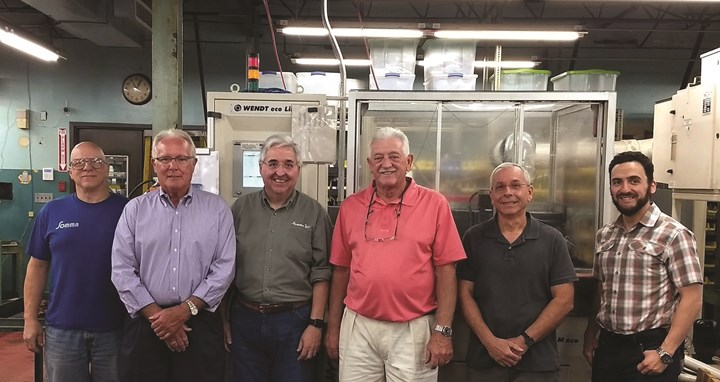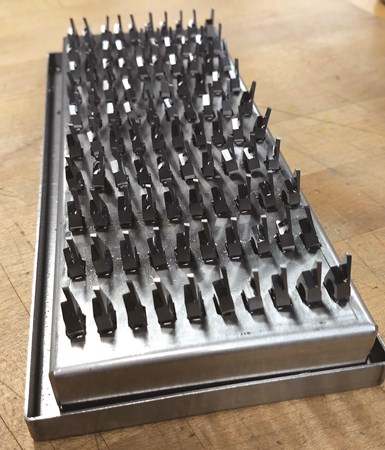Expanding Offerings with Max-Bar Tooling
Somma Tool Co. has a history of taking advantage of opportunities to help the business thrive. Recently, Somma Tool found a way to expand its product line, and market, by acquiring the Max-Bar Tool Co.

Owners of Somma Tool and former owners of Max-Bar Tooling.
Left to right: Tom Minuto, Wayne Hogrefe (Max-Bar), Eric Somma, Bob Hurlbut (Max-Bar), Jerry Somma and Rob Somma.
PMPA: How long has Somma Tool been in business?
Rob Somma: We just celebrated our 80th anniversary. My great-grandfather, Gerard Somma, started the business in 1939 as a specialty form tool grinding house and then we expanded into other types of cutting tools, toolholders and workholding for primarily screw machines. About 25 years ago, we expanded into broaching and replaceable insert form tooling.
PMPA: What is your history with Somma Tool?
RS: I have been around the business my whole life, but I started full time in 2004 after I graduated from college. When I was about 14 or 15, my grandfather, Herman Somma, taught me form tool design so I was able to start full time doing that and then learned to design the custom broach tools we offer. I’m also involved with some CNC programming as well as general engineering; new product design or updates to existing products.
PMPA: Tell me the story about Max-Bar.
RS: Max-Bar was a local manufacturer about 10 minutes from our place, and they had been in business for about 40 years. We acquired Max-Bar in August 2019, which allowed us to expand our product line to serve our current customers and bring in new customers.

Max-Bar inserts are ground instead of molded, which provides a lot of benefits, accoding to Rob Somma.
Max-Bar allows us to offer cutting tools and holders for Swiss and CNC machines. We have been reselling them for a few years, and when the owners wanted to sell, we saw a great opportunity to bring their operations in-house and expand our line of tooling. We are now able to offer a universal toolholder, which can perform front turning, back turning, grooving, threading, cut-off and other operations. Plus, all the inserts are ground instead of molded, which provides a lot of benefits.
PMPA: Was the acquisition of Max-Bar part of a bigger plan?
RS: We didn’t necessarily set out to acquire another business, but we saw that CNC Swiss machines were becoming more popular, and our line was primarily for screw machines. So, the Max-Bar tools fit into our line perfectly.
PMPA: Is there a vision for Somma Tool?
RS: We want to continue to be synonymous with quality tools and customer service, and we think that adding Max-Bar to our product line will help us continue that for hopefully the next 80 years.
PMPA: Of what is Somma most proud?
RS: Our employees. We have great employees who have been here from as little as a few months to three employees who have been with us for over 50 years. To give you an example of how great our team is, we closed on the purchase of Max-Bar on August 8, and we had all the machines moved in and making parts only five days later. It was an incredible display of teamwork.
PMPA: Why do you value your PMPA membership?
RS: I really enjoy the National Technical Conferences—meeting everyone, finding out what needs they have, and how we can help solve a problem. I’ve also enjoyed the opportunities I’ve had to speak at the Technical Conference—giving back to the PMPA because I know they do a lot for our industry.
The PMPA is made up of a great group of members. I enjoy reading the ListServes, going to the conferences and seeing the information sharing. I think, “Wow, these guys are technically competitors and here they are helping each other out,” and it’s great to see that kind of cooperation and camaraderie.
Then you have groups like the NextGen Committee who provide succession planning and transfer of knowledge information. There is a lot of information available to PMPA members.
Related Content
Craftsman Cribsheet No. 128: Why Do Machinists Say Tenths Instead of Ten Thousandths?
In machinist parlance, a tenth is a tenth of a thousandth, not a tenth of an inch.
Read MoreMachining Unleaded Materials — Reliability is Possible
Leaded steel is no longer produced in the United States. How do shops approach unleaded brass and steel machining?
Read MoreDo You Have a Quoting Process?
The only way to have repeatable results is to have a process.
Read MoreA No/Low-Cost Solution to Employee Retention
Studies show a little employee recognition goes a long way. Here are the 5Ws to consider for success.
Read MoreRead Next
Do You Have Single Points of Failure?
Plans need to be in place before a catastrophic event occurs.
Read MoreA Tooling Workshop Worth a Visit
Marubeni Citizen-Cincom’s tooling and accessory workshop offers a chance to learn more about ancillary devices that can boost machining efficiency and capability.
Read More5 Aspects of PMTS I Appreciate
The three-day edition of the 2025 Precision Machining Technology Show kicks off at the start of April. I’ll be there, and here are some reasons why.
Read More







.jpg;maxWidth=300;quality=90)












